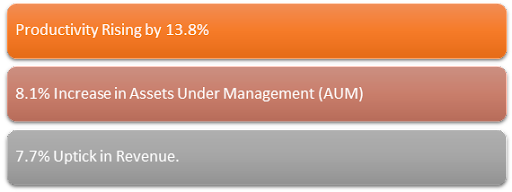#financial accounting
Text
Point-In-Time Financial Ratios
Calcbench has added ratios to our point-in-time standardized fundamentals stream. Now you can back-test the impact of changes in industry standard measures of profitability, liquidity and solvency. See the list of ratios @ https://www.calcbench.com/home/standardizedmetrics.
Ratios are calculated when filings are received. When one component of the ratio is revised a new ratio value is calculated and published with the timestamp of the component.
Calcbench’s point-in-time data is available from our API or on our bulk data page. For help getting the data contact [email protected].
Sample
2 notes
·
View notes
Text
Critical Role of Accrual Accounting in Enhanced Financial Reporting

Introduction
In the realm of business, financial reporting stands as the cornerstone of transparency and accountability. Every number, every decimal point carries a story, painting a vivid picture of a company's health, performance, and potential. However, the accuracy and reliability of this narrative heavily depend on the methodology used to record financial transactions. This is where Accrual accounting importance as a game-changer, offering a comprehensive view that goes beyond mere cash flow, ultimately enhancing financial reporting to a whole new level.
Understanding Accrual Accounting: A Paradigm Shift
Accrual accounting operates on the principle of matching revenues with expenses when they are incurred, rather than when cash changes hands. This fundamental shift in perspective brings about a more accurate representation of a company's financial position at any given time. It recognizes revenue when it is earned and expenses when they are incurred, aligning the financial statements more closely with the economic reality of business operations.
The Significance of Accrual Accounting in Financial Reporting Accuracy
Real-Time Insights: Accrual accounting provides a real-time view of financial activities, allowing stakeholders to make informed decisions based on current data rather than historical cash flows alone. This real-time visibility is crucial for strategic planning, risk management, and identifying growth opportunities.
Matching Principle: The matching principle, a core tenet of accrual accounting, ensures that revenues and their related expenses are recorded in the same accounting period. This not only reflects the true cost of generating revenue but also prevents distortions that can occur with cash-basis accounting, where income and expenses may be mismatched across different periods.
Accurate Performance Evaluation: By capturing expenses when they are incurred, accrual accounting provides a more accurate reflection of a company's profitability. This is particularly beneficial for businesses with long-term projects or contracts where revenue recognition occurs over time, allowing for a clearer assessment of project costs and profitability margins.
Enhanced Investor Confidence: Accrual accounting contributes to enhanced transparency and credibility in financial reporting, instilling confidence in investors and creditors. Accurate financial statements based on accrual accounting principles facilitate better risk assessment and decision-making, fostering trust and long-term relationships with stakeholders.
Navigating Challenges with Accrual Accounting
While accrual accounting offers numerous benefits, its implementation can pose challenges, especially for small businesses or those transitioning from cash-basis accounting. Understanding the complexities of accruals, adjusting entries, and maintaining consistency in recording transactions are key areas that require attention to ensure the integrity of financial reporting.
Conclusion: Empowering Financial Insights with Accrual Accounting
In conclusion, the critical role of accrual accounting in enhancing financial reporting accuracy cannot be overstated. It transforms financial statements from mere snapshots of cash movements to dynamic narratives that capture the true essence of a company's financial health and performance. By embracing accrual accounting principles, businesses unlock a treasure trove of insights that drive informed decision-making, foster investor confidence, and pave the way for sustainable growth in today's dynamic business landscape.
Remember, the journey towards accurate financial reporting starts with understanding the importance of accrual accounting and its transformative impact on financial transparency and credibility. Embrace this paradigm shift, and watch as your financial narratives evolve into powerful tools for success.
Suggested Link: -
Fraud Detection Strategies
financial reporting mistakes
Inventory optimization strategies
#financial accounting#financial reporting accuracy#Accural Accounting Importance#Accounting strategies
0 notes
Text

My Experience with Financial Accounting Assignment Help from DoMyAccountingAssignment.com
As a student grappling with the complexities of financial accounting, I often found myself overwhelmed with the sheer volume of concepts, formulas, and theories that needed to be understood and applied in my assignments. Despite dedicating countless hours to studying and practicing, I still struggled to grasp some of the fundamental principles of accounting.
In my quest to find assistance, I stumbled upon DoMyAccountingAssignment.com, a website that promised expert guidance and support for students like me seeking help with their financial accounting assignments. Skeptical yet hopeful, I decided to give it a try, and little did I know that it would turn out to be a game-changer for me.
Initial Impressions:
Upon landing on the website, I was greeted by a clean and user-friendly interface that immediately instilled confidence in me. The homepage was neatly organized, with clear navigation options guiding me to the section specifically tailored for financial accounting assignment help.
Seamless Ordering Process:
Placing an order for financial accounting assignment help was a breeze. The website offered a simple and intuitive order form where I could provide all the necessary details regarding my assignment, including the topic, deadline, and any specific instructions from my professor. Additionally, the option to communicate directly with the assigned expert was a feature I particularly appreciated, as it allowed me to convey my requirements effectively.
Expert Assistance:
One of the standout features of DoMyAccountingAssignment.com is undoubtedly the caliber of experts they have on board. The individual assigned to assist me with my financial accounting assignment was not only highly qualified but also possessed extensive practical experience in the field. Their expertise was evident from the insightful explanations and well-researched solutions they provided, which not only helped me understand the concepts better but also improved my overall comprehension of the subject.
Timely Delivery:
Meeting deadlines is crucial in academia, and I was delighted to find that DoMyAccountingAssignment.com takes punctuality seriously. Despite the complexity of my assignment, the expert assigned to me delivered the completed work well before the stipulated deadline, giving me ample time to review the solutions and seek clarifications if needed. This level of efficiency and reliability further reinforced my confidence in their services.
Comprehensive Support:
What sets DoMyAccountingAssignment.com apart is their commitment to providing comprehensive support to students. Beyond simply delivering solutions to assignments, they also offer additional resources such as study materials, reference guides, and practice exercises to aid in understanding complex topics. Moreover, the customer support team was readily available to address any queries or concerns I had, ensuring a smooth and hassle-free experience from start to finish.
Value for Money:
As a student, budget constraints are always a concern, but I found the pricing structure of DoMyAccountingAssignment.com to be reasonable and transparent. The website offers competitive rates without compromising on the quality of service, making it an affordable option for students from diverse backgrounds.
Conclusion:
In conclusion, my experience with financial accounting assignment help from DoMyAccountingAssignment.com has been nothing short of exceptional. From the seamless ordering process to the expert assistance and timely delivery, every aspect of their service exceeded my expectations. Thanks to their invaluable support, I not only aced my assignment but also gained a deeper understanding and appreciation for the subject. I wholeheartedly recommend DoMyAccountingAssignment.com to any student seeking reliable and effective assistance with their accounting assignments.
#Reviews#financial accounting#financial accounting assignment help#Accounting#Assignment Help#Online Education
0 notes
Text
8 Savings Secrets: Boost Your Wealth with Smart Money Moves!

8 Savings Secrets: Boost Your Wealth with Smart Money Moves!
Discover practical savings strategies that work wonders! Easy tips to grow your wealth without stress. Start now!

In the dynamic landscape of personal finance, mastering the art of savings is not just a prudent choice; it’s a fundamental strategy for achieving lasting financial prosperity. This extensive guide delves into ten robust savings strategies, meticulously exploring each one to provide a comprehensive understanding of how they can pave the way to wealth accumulation. From the core principles of wealth definition to the intricate details of tax-efficient strategies, this article aims to empower readers with actionable insights for financial success.

1. Introduction
1.1. Definition of Wealth Accumulation
The journey to financial prosperity begins with a clear understanding of wealth accumulation. It’s not merely about accumulating money but strategically growing one’s net worth over time. Wealth accumulation involves making informed decisions, channeling savings into investments that yield substantial returns.
1.2. Importance of Savings Strategies
Saving strategies serve as the cornerstone of financial success. They are not just guidelines; they are the roadmap that transforms the act of saving into a dynamic process of wealth creation. By adopting and implementing these strategies, individuals can navigate the complex financial landscape with confidence and purpose.

Understanding Financial Goals
2.1. Setting Clear Objectives
The first step in any successful savings strategy is setting clear financial objectives. Whether it’s buying a home, funding education, or retiring comfortably, defining these goals provides a roadmap for effective financial planning. Clear objectives serve as the guiding stars that shape the trajectory of one’s financial journey.
2.2. Differentiating Short-Term and Long-Term Goals
Recognizing the difference between short-term and long-term goals is crucial. Short-term goals might involve creating an emergency fund or planning a vacation, while long-term goals encompass significant life events such as purchasing a home or securing a comfortable retirement. This differentiation informs the approach to saving.
2.3. Aligning Goals with Savings Strategies
The synergy between financial goals and savings strategies is paramount. Each saving strategy should be tailored to align with specific financial goals, ensuring a harmonious and purpose-driven approach to wealth creation.

3. Budgeting Techniques
3.1. Importance of Budgeting
Budgeting is not about restriction; it’s about empowerment. It is the key to understanding the flow of finances, enabling conscious decision-making on spending, and most importantly, designating a portion of income to systematic saving. A well-constructed budget is a tool for financial liberation.
3.2. Creating a Comprehensive Budget
Crafting a comprehensive budget involves a meticulous breakdown of income and expenses. This process not only sheds light on areas where expenses can be trimmed but also establishes the groundwork for allocating funds to various saving goals. A budget is not just a financial document; it’s a strategic plan for wealth creation.
3.3. Allocating Savings within the Budget
Budgeting is incomplete without a deliberate allocation for savings. This step ensures that saving becomes an integral and non-negotiable component of financial planning, fostering a disciplined approach to wealth creation. It transforms savings from a mere afterthought to a proactive and intentional financial habit.
"Don't save what is left after spending but spend what is left after saving." Warren Buffet
4. Emergency Fund Essentials
4.1. Significance of Emergency Funds
Life is unpredictable, and emergencies can strike at any moment. An emergency fund acts as a financial safety net, providing peace of mind and a buffer against unforeseen circumstances such as sudden medical expenses or unexpected job loss. Understanding its significance is pivotal for financial security.
4.2. Determining the Ideal Emergency Fund Size
The ideal size of an emergency fund is subjective, influenced by factors such as monthly expenses, job stability, and the presence of dependents. Tailoring the fund size to individual circumstances ensures adequate coverage during turbulent times, safeguarding financial stability.
4.3. Strategies for Building and Maintaining an Emergency Fund
Building and maintaining an emergency fund require strategic planning. Strategies include setting aside a fixed percentage of each paycheck, exploring high-interest savings accounts, and periodically reassessing the fund size to accommodate changes in financial circumstances.

5. Investment Diversification
5.1. Introduction to Investment Diversification
Investment diversification is the antidote to financial risk. It involves spreading investments across various asset classes to ensure that the performance of one does not unduly impact the overall portfolio. Diversification is the key to creating a resilient and balanced investment portfolio.
5.2. Types of Investments for Diversification
Diversification can be achieved through a variety of investments, including stocks, bonds, real estate, and alternative investments. Understanding the risk and return profiles of each asset class is crucial for effective diversification. It’s not just about spreading investments but doing so strategically.
5.3. Balancing Risk and Reward
Striking a delicate balance between risk and reward is the essence of investment diversification. While higher-risk investments may promise greater returns, a well-balanced portfolio aligns risk with individual risk tolerance and long-term financial goals. It’s about maximizing returns without exposing oneself to undue financial vulnerabilities.

6. Retirement Planning
6.1. The Necessity of Retirement Planning
Retirement might seem like a distant future, but the earlier you start planning, the more comfortable your golden years will be. Retirement planning is not just a financial task; it’s a lifestyle choice that ensures you enjoy the fruits of your labor in later life. It’s about creating a roadmap for a fulfilling and financially secure retirement.
6.2. Types of Retirement Accounts
Understanding the different types of retirement accounts, such as 401(k)s and IRAs, is paramount. These accounts offer tax advantages and compound interest, setting the stage for a financially secure retirement. Choosing the right retirement accounts is a strategic move towards long-term financial stability.
6.3. Maximizing Contributions for Long-Term Gains
Contributing the maximum allowable amount to your retirement accounts is a strategic move. Taking advantage of employer matches and consistently investing in your retirement fund ensures long-term financial stability. It’s about capitalizing on compounding interest and harnessing the power of consistent contributions.

7. Automated Savings
7.1. Advantages of Automated Savings
In a world where time is a precious commodity, automated savings simplify the saving process. By setting up automatic transfers to your savings accounts, you ensure that a portion of your income is saved before you even have the chance to spend it. Automation is the key to cultivating a consistent and hassle-free savings habit.
7.2. Setting Up Automatic Transfers
Setting up automatic transfers involves linking your checking accounts to savings accounts. This seamless process ensures that a predetermined amount is transferred regularly, fostering consistent savings habits without requiring constant manual intervention. It’s about making savings a seamless part of your financial routine.
7.3. Overcoming Common Challenges in Automation
While automated savings offer convenience, challenges such as irregular income or unexpected expenses may arise. Planning for these contingencies ensures that the automation process remains effective even in the face of life’s uncertainties. Overcoming challenges is about creating a robust and resilient automated savings system.

8. Cutting Unnecessary Expenses
8.1. Identifying Non-Essential Expenses
Identifying and categorizing non-essential expenses is a crucial step in effective expense reduction. This process involves distinguishing between wants and needs, allowing you to make informed decisions about where to cut back. It’s about understanding the true value of your expenditures.
8.2. Practical Strategies for Expense Reduction
Practical strategies for cutting expenses include negotiating bills, buying generic brands, and avoiding impulse purchases. Implementing these strategies not only reduces your overall spending but also frees up more money to redirect towards your savings goals. It’s about making conscious choices that align with your financial objectives.
8.3. Redirecting Saved Money to Savings
Cutting back on expenses is only half the battle; the other half is ensuring that the money saved doesn’t find its way back into discretionary spending. A proactive approach involves promptly redirecting the money saved from expense reduction to your savings accounts. It’s about making every saved dollar work towards your financial goals.

9. Taking Advantage of Tax Benefits
9.1. Understanding Tax-Advantaged Accounts
The tax code offers various incentives for savers. Understanding tax-advantaged accounts, such as Health Savings Accounts (HSAs) and Individual Retirement Accounts (IRAs), provides opportunities to minimize your tax liability and maximize your savings. It’s about leveraging the tax code to amplify the impact of your savings.
9.2. Leveraging Tax Deductions and Credits
Certain contributions to retirement accounts, like 401(k)s, may be tax-deductible. Leveraging these deductions, along with taking advantage of available tax credits, can significantly impact your overall savings. It’s about optimizing your tax situation to create a more favorable environment for wealth accumulation.
9.3. Optimizing Savings through Tax-Efficient Strategies
Optimizing savings through tax-efficient strategies involves aligning your financial decisions with their tax implications. This may include strategic withdrawals during retirement to minimize tax burdens, ensuring that your savings work most effectively for you. It’s about being intentional in your financial planning to maximize benefits.

10. Regular Financial Checkups
10.1. Importance of Periodic Financial Evaluations
Your financial journey is dynamic, with circumstances evolving over time. Regular financial checkups are essential to assess the effectiveness of your savings strategies. Changes in income, expenses, or financial goals may necessitate adjustments to your existing plan. It’s about staying vigilant and responsive to the ever-changing financial landscape.
10.2. Adjusting Savings Strategies Based on Financial Health
Flexibility is a key element in financial planning. Adjusting your savings strategies based on changes in your financial health ensures that your approach remains relevant and effective. Being adaptable allows you to navigate the ever-changing landscape of personal finance with confidence. It’s about responding proactively to shifts in your financial circumstances.
10.3. Seeking Professional Financial Advice
While self-guided financial planning is commendable, seeking professional financial advice is a wise move, especially when dealing with intricate decisions. Financial advisors bring expertise and a broader perspective to help you make informed choices aligned with your unique circumstances. It’s about tapping into the knowledge and experience of professionals to enhance your financial decision-making.

Conclusion
In conclusion, these ten savings strategies are not mere theories but practical tools that can reshape your financial destiny. Whether you’re starting your financial journey or seeking to enhance an existing plan, incorporating these strategies can be the catalyst for true financial prosperity. Remember, the key isn’t just in saving money; it’s in strategically making those savings work for you through thoughtful investments and financial planning.

#accounting#banking#finance#investment#personal finance#cfo#financial literacy#financial accounting#financial modeling#financial planning#savings#saving money#businesses#money#business#financial#budget
0 notes
Link
Miss Yin Myat Min stands out as a beacon of expertise and integrity in the world of financial consultancy. With a robust academic foundation from the University of Economic Yangon, where she earned both her Bachelor of Commerce and Master of Public Administration, Miss Yin has carved a niche for herself in the financial sector over an illustrious 30-year career.
#finance#financial#economy#financial accounting#MissYinMyatMin#EconomicGrowth#financialconsultant#financialtrends#UAE
0 notes
Text
Morne Patterson - Cost and Management Accounting Vs Financial Management
0 notes
Text
Optimize Your Finances: Olivo Tech's Top-notch Software in Saudi Arabia 🚀💼
Unlock the potential of your business with Olivo Technologies' cutting-edge financial software in Saudi Arabia. 🌐 Our cloud accounting software has been the driving force behind the success of numerous businesses, propelling them to new heights.
Experience the power of seamless financial management that Olivo Technologies brings to the table. Our commitment to excellence has forged lasting relationships with top firms in Saudi Arabia. 🏢
Trust in our proven track record, as we consistently deliver exceptional services and reliable solutions. Join hands with Olivo Technologies and witness the transformative impact on your financial journey. 💪Take control of your financial success. Discover Olivo Tech's powerful solutions today! 💻📈https://olivotech.com/accounting-software/
#accounting software#cloud accounting#accounting service provider#financial accounting#financial services
0 notes
Text

ITS A RESTART ~
Ok so I have my SEM2 exams from March till the 3rd week of April (wish me luck, I'm very scared...I had messed up my SEM1 . So I hope 🤞 I don't mess things up this time 😭)
So basically I'm gonna study this whole month
My main focus should be on math and accounts...
#academic validation#studies#study blog#study#study aesthetic#study motivation#dark academia#financial accounting#mathematics#Spotify
0 notes
Text

MARG ERP Automobile Industry Software helps automobile dealerships and workshops handle sales and services. It is simple to implement in any automotive industry and is meant to overcome expected obstacles such as providing high-quality customer service, inventory, delivery management, and labor efficiency.
Marg ERP Automotive software addresses all areas of the automotive industry, from dealer operations to managing critical components like vehicle sales, workshop activities, spare parts inventory, and financial accounting. The software offers several unique capabilities, including quality management, purchase management, billing, financial accounting, service management, inventory management, service management, and order management.
#purchase management#billing#financial accounting#service management#inventory management#Automobile Industry Software#margerp
0 notes
Text
His face right here is the same face I made when I realized I have to read this book in order to understand said book 💀

#studyblr#study motivation#graduate student#business student#financial accounting#business accounting#jungkook#3d jungkook#kpop#music video#music#ugh#textbook#this rental cost me $130#it should be illegal to cost so much to get mandatory textbooks#music i study to#reading#learning#study blog#studyspo#studying#business studies#learning new things#finance#digital books#business courses#books#graduate school#graduate studies#mba
1 note
·
View note
Text
Challenging Topics in Financial Accounting along with sample question and answers
Hello students,
Wondering Whom I can rely upon to Do My financial accounting Assignment for Me?
Don't worry, we have got you covered
Financial accounting is a critical aspect of managing a business's financial health. Certain topics within this domain can pose challenges, demanding a thorough grasp for effective application. In this blog, we are going to see some tough topics in financial accounting as well as some important questions along with answers which is beneficial for students.
Let's delve into tough areas:
1. Consolidation of Financial Statements:
Consolidation involves the process of combining the financial statements of a parent company and its subsidiaries. This process aims to present a unified and comprehensive view of the financial position, performance, and cash flows of the entire group.
2. Fair Value Accounting:
Fair value accounting involves valuing assets and liabilities based on their current market value rather than their historical cost. It aims to provide a more accurate reflection of an asset or liability's worth in the current market conditions.
3. Accounting for Derivatives:
Derivatives, such as futures or options contracts, are financial instruments whose values are derived from underlying assets, indices, or entities. Accounting for derivatives involves recognizing and measuring these instruments at fair value on the balance sheet.
4. Revenue Recognition:
Revenue recognition is a pivotal accounting principle determining when and how to record revenue in financial statements. It outlines guidelines for recognizing revenue from the sale of goods or services when it is earned and reasonably assured of being collected.
5. Accounting for Intangible Assets:
Intangible assets lack physical substance but hold significant value for a company. These assets include patents, trademarks, copyrights, goodwill, and proprietary technologies. Accounting for intangible assets involves their initial recognition, valuation, and subsequent measurement in financial statements.
6. Accounting for Income Taxes:
Accounting for income taxes involves recognizing and measuring taxes payable or receivable in a company's financial statements, reflecting the difference between taxable income and accounting income.
Let's delve into sample question and answers:
Question: How does accounting for income taxes differ from tax reporting?
Answer: Accounting for income taxes follows GAAP principles, recognizing taxes based on profit/loss, while tax reporting adheres to tax laws set by authorities.
Sample Question: Explain a situation where temporary differences between book and tax accounting can arise.
Sample Answer: Temporary differences occur when income or expenses are recognized in different periods for tax and accounting purposes, leading to deferred tax liabilities/assets.
Question: What is the consolidation of financial statements?
Answer: Consolidation involves combining financial statements of parent and subsidiary companies. It aims to present a single, comprehensive set of financials to reflect the economic reality of the group as a whole.
Sample Question:
Why is the consolidation of financial statements necessary for group reporting purposes?
Sample Answer: Consolidation provides a holistic view of the group's financial position, eliminating duplications and portraying an accurate picture to stakeholders.
Question:
What is fair value accounting, and how is it different from historical cost accounting?
Answer: Fair value accounting involves valuing assets and liabilities at their current market value, whereas historical cost accounting records transactions based on the original cost incurred.
Sample Question: Explain a scenario where fair value accounting is preferable over historical cost accounting.
Sample Answer: Fair value accounting is advantageous in volatile markets where assets' market values fluctuate significantly, providing more relevant and up-to-date information to users.
Question: How are derivatives accounted for in financial statements? Answer: Derivatives are recorded at fair value on the balance sheet. Changes in fair value are recognized in income statements or other comprehensive income, depending on their classification.
Sample Question: What are the risks associated with accounting for derivatives, and how can they impact financial reporting?
Sample Answer: Derivative accounting involves complexities due to market fluctuations, potentially impacting financial statements' accuracy and reflecting unrealized gains/losses.
Question: What are the core principles of revenue recognition in accounting?
Answer: Revenue recognition principles entail identifying when to recognize revenue, usually when it's earned and realized or realizable.
Sample Question: How does the timing of revenue recognition impact financial statements?
Sample Answer: Premature or delayed recognition of revenue can misrepresent a company's financial performance and may affect investors' perceptions.
Conclusion
Financial accounting encompasses intricate topics crucial for sound financial reporting and decision-making. Mastering these complex areas demands a deep understanding of principles and their application in real-world scenarios.
Practice and comprehension of sample questions aid in solidifying knowledge, enabling professionals to navigate these tough topics proficiently and ensure accurate financial reporting.
This blog aims to shed light on six challenging topics within financial accounting, offering sample questions and answers to facilitate a better understanding. Mastering these concepts empowers individuals to handle the complexities inherent in these areas effectively.
#pay to do assignment#domyaccountingassignment#homework help#college#education#domyaccountingassignmentforme#financial accounting assignment help#financial accounting
1 note
·
View note
Text
The Power of Forensic Accounting: Detecting Financial Fraud

Introduction
In today's rapidly evolving business landscape, the specter of financial fraud looms large, threatening the very foundation of trust and integrity that underpins our economic systems. As businesses strive for success and investors seek lucrative opportunities, the need for robust fraud detection strategies has never been more critical. This is where the power of forensic accounting shines bright, offering a potent arsenal of methods and strategies to unearth fraudulent activities and safeguard financial interests.
Forensic Accounting Methods
Forensic accounting, often dubbed as the "detective work" of the accounting world, employs a diverse range of methods to delve deep into financial records and transactions. These methods go beyond traditional auditing practices, focusing on meticulous analysis, reconstruction, and interpretation of financial data. Here are some key forensic accounting methods that play a pivotal role in fraud detection:
Data Analysis and Pattern Recognition: Forensic accountants leverage advanced data analytics tools to identify irregular patterns, anomalies, and outliers in financial data. By scrutinizing transactional records, they can pinpoint suspicious activities that may indicate fraudulent behavior.
Digital Forensics: With the increasing digitization of financial systems, digital forensics has become indispensable in fraud investigations. Forensic accountants use specialized software and techniques to recover and analyze electronic evidence, such as emails, chat logs, and digital transactions, providing valuable insights into fraudulent activities.
Document Examination: Examining financial documents, such as invoices, receipts, and contracts, is another crucial aspect of forensic accounting. By meticulously reviewing these documents for discrepancies, forgeries, or inconsistencies, forensic accountants can uncover fraudulent schemes designed to deceive stakeholders.
Interviews and Interrogations: In cases where fraud is suspected, forensic accountants conduct interviews and interrogations to gather testimonial evidence and confront individuals involved in fraudulent activities. These interactions can reveal valuable information and help build a comprehensive understanding of the fraud scheme.
Fraud Detection Strategies
The battle against financial fraud requires proactive strategies that not only detect ongoing fraud but also deter potential perpetrators. Forensic accountants employ a combination of techniques and best practices to strengthen fraud detection efforts:
Risk Assessment: Conducting thorough risk assessments is the first step in designing effective fraud detection strategies. Forensic accountants evaluate internal controls, identify potential vulnerabilities, and prioritize areas of heightened risk, enabling targeted fraud prevention measures.
Continuous Monitoring: Implementing continuous monitoring mechanisms allows organizations to detect fraud in real time or near-real time. Automated alerts, anomaly detection algorithms, and transaction monitoring systems are valuable tools that enhance fraud detection capabilities.
Whistleblower Programs: Encouraging a culture of transparency and accountability is vital in combating fraud. Whistleblower programs provide channels for employees, stakeholders, and the public to report suspected fraudulent activities confidentially, fostering early detection and intervention.
Fraud Awareness Training: Educating employees and stakeholders about common fraud schemes, red flags, and reporting procedures is essential for building a vigilant workforce. Forensic accountants play a key role in delivering targeted training programs that empower individuals to recognize and respond to potential fraud risks.
Conclusion:
In the realm of digital marketing, where trust and credibility are paramount, the power of forensic accounting in detecting financial fraud cannot be overstated. By leveraging advanced methods, strategic approaches, and proactive strategies, forensic accountants serve as guardians of financial integrity, safeguarding businesses, investors, and stakeholders from the devastating impacts of fraud. Embracing forensic accounting as a cornerstone of your fraud detection framework is not just a prudent decision—it's a powerful commitment to transparency, accountability, and ethical business practices.
By these robust forensic accounting methods and fraud detection strategies into your organization's risk management framework, you can fortify your defenses against financial fraud and pave the way for sustainable growth and success.
Remember, in the fight against financial fraud, knowledge is power, and proactive vigilance is the key to staying one step ahead of fraudulent actors. Together, let's build a future where integrity and transparency reign supreme, ensuring a level playing field for businesses and investors alike.
Stay vigilant. Stay informed. Stay ahead of financial fraud.
Suggested Blogs: -
financial reporting mistakes
Inventory optimization strategies
Financial planning strategies
0 notes
Text

Precision in numbers, excellence in service
Empowering your business with our trusted accounting services.
#mumbai#pune#deltaadvisor#followformore#services#businessgrowth#finance#financial#accounting#accountingservices#followfomore#businesshelp
#business advisory#financial advisory#business consulting#strategic advisors#financial and accounting advisory services#financial accounting
0 notes
Text
Unlocking Clarity: Internal vs. External Audits Demystified | 10 Years of Expert Insight!
Unlocking Clarity: Internal vs. External Audits Demystified | 10 Years of Expert Insight!
Discover the nuances between internal and external audits. Gain valuable insights for a robust audit strategy. Your go-to guide! | Deciphering audits for success.

Internal Audit and External Audit: Understanding the Key Distinctions
In the realm of corporate governance and financial management, audits play a pivotal role in ensuring transparency, accuracy, and compliance with regulations. Two primary forms of audits, internal and external, serve distinct purposes within organizations. Understanding the differences between internal audit and external audit is essential for stakeholders, management, and regulatory bodies alike. In this comprehensive guide, we delve into the intricacies of both types of audits, exploring their scope, methodologies, and contributions to organizational governance.

1. Introduction to Internal and External Audit
1.1. Defining Internal Audit
Internal audit constitutes an independent, objective assurance and consulting activity designed to add value and improve an organization’s operations. It helps an organization accomplish its objectives by bringing a systematic, disciplined approach to evaluate and improve the effectiveness of risk management, control, and governance processes.
1.2. Defining External Audit
External audit, on the other hand, is an independent examination of financial information of any entity, whether profit-oriented or not, irrespective of its size or legal form, when such an examination is conducted with a view to expressing an opinion thereon. It is conducted by an external auditor, who is appointed by the shareholders or governing body of an organization.

2. Purpose and Scope
2.1. Internal Audit Purpose
Internal audits are conducted to evaluate and improve the effectiveness of risk management, control, and governance processes within an organization. They provide insights into operational efficiency, compliance with policies and procedures, and the overall management of risk across various business functions.
Summary
Focus on Organizational Processes.
Delving into the intricacies of day-to-day operations.
Identifying inefficiencies and proposing enhancements.
Evaluating Internal Controls.
Scrutinizing the effectiveness of internal control mechanisms.
Mitigating the risk of fraud and operational lapses.
Risk Management.
Proactively managing risks inherent in business processes.
Developing strategies for risk mitigation and resilience.
2.2. External Audit Purpose
External audits primarily focus on providing assurance to stakeholders regarding the accuracy and reliability of financial statements. They verify the fairness of financial presentations and ensure compliance with relevant accounting standards and regulatory requirements.
Summary
Financial Statement Examination.
In-depth analysis of financial records and transactions.
Ensuring accuracy and reliability of financial reporting.
Compliance Verification.
Verifying adherence to legal and regulatory requirements.
Providing stakeholders with assurance on compliance.
Stakeholder Assurance.
Assuring external parties of the organization’s financial health.
Fostering trust among shareholders and investors.

3. Authority and Independence
3.1. Internal Audit Authority
Internal audit functions typically report to the highest levels of management within an organization, such as the board of directors or audit committee. They operate independently from operational areas to maintain objectivity and impartiality in their assessments.
Summary
Direct Reporting to Management.
Reporting directly to the organization’s management.
Facilitating immediate corrective actions.
Advisory Role.
Serving as an advisory body to improve internal processes.
Providing insights for strategic decision-making.
Employed by the Organization.
Internal auditors as part of the organizational structure.
Potential for internal biases and conflicts.
Potential Bias Concerns.
Navigating challenges associated with internal allegiances.
Striving for objectivity within the organizational context.
3.2. External Audit Authority
External auditors are appointed by shareholders or governing bodies and report directly to them. This independence from the organization ensures an unbiased evaluation of financial statements, enhancing the credibility of the audit process.
Summary
Independent Reporting to Shareholders.
Maintaining independence from internal biases.
Reporting findings directly to shareholders.
Regulatory Compliance Focus.
Emphasizing adherence to legal and regulatory standards.
Offering an objective assessment of compliance.
Independent from the Organization.
External auditors operate autonomously.
Minimizing biases and conflicts of interest.
Objective Evaluation.
Delivering an objective assessment of financial matters.
Prioritizing external stakeholders’ interests.
"Americans like to make money; Canadians like to audit it. I know no other country where accountants have a higher social and moral status." Northrop Frye
4. Focus Areas
4.1. Internal Audit Focus
Internal audits concentrate on evaluating operational efficiency, ensuring compliance with internal policies and procedures, and identifying areas of potential risk. They delve into the intricacies of day-to-day processes to enhance overall organizational performance.
Summary
Process Improvement.
Prioritizing the enhancement of internal processes.
Contributing to organizational efficiency and effectiveness.
Operational Efficiency.
Identifying opportunities for streamlining operations.
Addressing challenges that impact day-to-day efficiency.
4.2. External Audit Focus
External audits primarily focus on the accuracy of financial statements, compliance with accounting standards, and the detection of fraud or misstatements. The emphasis is on providing stakeholders with confidence in the financial information presented by the organization.
Summary
Financial Accuracy.
Ensuring precision in financial reporting.
Verifying the accuracy of financial statements.
Compliance Assurance.
Providing assurance on adherence to legal and regulatory standards.
Delivering confidence to external stakeholders.

5. Reporting Structure
5.1. Internal Audit Reporting
Internal audit reports are directed to the management of the organization. These reports include recommendations for improvement in processes, controls, and risk management based on the findings of the audit.
Summary
Direct Reporting to Management.
Reporting directly to the organization’s management.
Facilitating immediate corrective actions.
Advisory Role.
Serving as an advisory body to improve internal processes.
Providing insights for strategic decision-making.
5.2. External Audit Reporting
External auditors provide reports directly to the shareholders or the board of directors. These reports contain opinions on the fairness of the financial statements and the adherence to accounting principles.
Summary
Independent Reporting to Shareholders.
Maintaining independence from internal biases.
Reporting findings directly to shareholders.
Regulatory Compliance Focus.
Emphasizing adherence to legal and regulatory standards.
Offering an objective assessment of compliance.

6. Frequency and Timing
6.1. Internal Audit Frequency
Internal audits can be conducted on an ongoing or periodic basis, depending on the organization’s needs. They are not limited to specific timeframes and can be scheduled throughout the year.
Summary
Continuous or Periodic.
A continuous process with ongoing assessments.
Periodic deep dives into specific operational areas.
Regular Assessments.
Ensuring ongoing alignment with organizational goals.
Real-time monitoring for effective risk management.
6.2. External Audit Frequency
External audits are typically an annual requirement, timed after the completion of financial periods. This ensures a comprehensive examination of the financial statements at the end of each fiscal year.
Summary
Annual or Periodic.
Typically conducted annually or periodically.
Focused on the financial year-end for comprehensive reviews.
Focused on Financial Year-End.
Ensuring the accuracy of year-end financial statements.
Aligning with regulatory reporting timelines.

7. Key Personnel and Teams
7.1. Internal Audit Team
Internal audit teams are usually employed by the organization itself. They report to the board or audit committee and are intimately familiar with the organization’s internal processes and controls.
7.2. External Audit Team
External audit teams, on the other hand, are independent audit firms hired by shareholders or the board. This independence ensures an unbiased evaluation of financial statements and internal controls.

8. Risk Management and Compliance
8.1. Internal Audit Role in Risk Management
Internal audits play a crucial role in identifying and mitigating risks associated with operational processes. They ensure compliance with internal policies and procedures, reducing the likelihood of financial and operational setbacks.
Summary
Operational Risks.
Identifying and mitigating risks associated with operations.
Enhancing operational resilience through proactive measures.
Internal Fraud.
Addressing the risk of internal fraud and misconduct.
Safeguarding organizational assets and resources.
8.2. External Audit Role in Risk Management
External audits focus on assessing financial risks and verifying compliance with accounting standards. While they may not delve as deeply into operational risks, they contribute significantly to overall risk management by ensuring financial accuracy.
Summary
Financial Misstatements.
Vigilantly assessing the risk of financial inaccuracies.
Providing assurance on the accuracy of financial records.
Non-Compliance Risks.
Identifying risks associated with non-compliance.
Assuring stakeholders of the organization’s commitment to compliance.

9. Documentation and Record Keeping
9.1. Internal Audit Documentation
Internal audit documentation is detailed and comprehensive, encompassing reports and findings, process flows, and control assessments. This documentation serves as a foundation for improving internal processes.
9.2. External Audit Documentation
External audit documentation primarily includes audited financial statements, working papers, and test documentation. These documents provide evidence of the audit process and support the auditor’s opinions on financial statements.

10. Confidentiality and Disclosure
10.1. Internal Audit Confidentiality
Internal audit findings are typically kept confidential within the organization. The focus is on improving internal processes, and disclosure is limited to the management or specific departments involved.
Summary
Internal Information Handling.
Safeguarding internal information with stringent confidentiality measures.
Balancing transparency with the need for confidentiality.
Limited External Disclosures.
Minimizing external disclosures of internal processes.
Prioritizing the security of sensitive organizational information.
10.2. External Audit Disclosure
External audits involve public disclosure of financial statements. The information provided in external audit reports is accessible to external stakeholders, ensuring transparency and accountability.
Summary
Public Disclosures.
Adhering to regulatory requirements for public disclosures.
Balancing transparency with legal obligations.
Limited Confidentiality.
Navigating constraints related to public disclosures.
Emphasizing the importance of transparency within legal bounds.

11. Regulatory Oversight and Compliance
11.1. Internal Audit Regulation
Internal audits may be conducted to ensure compliance with internal controls and policies, often voluntarily or as mandated by industry standards. Regulatory oversight is generally limited to specific sectors or industries.
Summary
Internal Policies.
Guided by internal policies and organizational guidelines.
Adhering to industry-specific standards.
Industry Guidelines.
Aligning with industry benchmarks and best practices.
Navigating sector-specific regulatory landscapes.
11.2. External Audit Regulation
External audits are mandated by government regulations, and regulatory bodies often oversee the auditing profession. Compliance with accounting standards is a critical aspect of external audit regulations.
Summary
Statutory Requirements.
Mandated by statutory regulations governing external audits.
Ensuring compliance with universally accepted accounting principles.
Compliance with Accounting Standards.
Adhering to international accounting standards.
Providing a standardized framework for financial reporting.

12. Cost and Resource Allocation
12.1. Internal Audit Costs
Internal audit costs are typically incorporated into the operational budgets of organizations. The allocation of resources depends on the size and complexity of the organization.
Summary
In-House Expenses.
Involving internal personnel and resources.
Managing costs associated with internal audits.
Resource Allocation.
Allocating internal resources for audit activities.
Balancing costs with the benefits of continuous internal oversight.
12.2. External Audit Costs
External audit costs involve contractual fees paid to audit firms. The fees are based on the complexity and scope of the audit, reflecting the level of effort required by the external audit team.
Summary
External Firm Fees.
Engaging external audit firms for independent reviews.
Incurring fees for external expertise.
Cost of Compliance.
Balancing the costs associated with ensuring compliance.
Weighing the benefits of external assurance against financial outlays.

13. Value Addition and Benefit
13.1. Internal Audit Value Addition
Internal audits add value by identifying process improvements, strengthening internal controls, and providing insights into operational efficiency. Their focus on internal processes enhances overall organizational effectiveness.
13.2. External Audit Value Addition
External audits enhance financial transparency by ensuring the accuracy of financial statements. Their opinions provide assurance to stakeholders and investors, contributing to the overall credibility of the organization.

14. Challenges and Limitations
14.1. Internal Audit Challenges
Internal audits may face challenges such as limited resources and budgets. Ensuring independence from management while working closely with operational areas can also pose challenges.
14.2. External Audit Challenges
External audits encounter challenges related to the complexity of financial transactions and the evolving landscape of regulatory requirements. Staying abreast of changes is crucial for maintaining audit effectiveness.

15. Collaboration and Communication
15.1. Internal Audit Collaboration
Internal audits involve collaboration with various departments and levels of management. They play a key role in facilitating process improvement initiatives by working closely with operational areas.
Summary
Immediate Corrections.
Implementing swift corrective actions based on findings.
Addressing identified weaknesses promptly.
Continuous Improvement Plans.
Developing long-term strategies for ongoing improvement.
Fostering a culture of continuous enhancement.
15.2. External Audit Communication
External audits require effective communication with management and audit committees. Providing feedback and recommendations based on audit findings is essential for ensuring continuous improvement.
Summary
Compliance Recommendations.
Offering recommendations for addressing compliance gaps.
Providing a roadmap for achieving and maintaining compliance.
Legal Consequences.
Highlighting potential legal consequences of non-compliance.
Emphasizing the importance of proactive adherence to regulations.

16. Continuous Improvement and Evolution
16.1. Internal Audit Evolution
Internal audits evolve by embracing technology and automation. The incorporation of data analytics and artificial intelligence enhances the efficiency and effectiveness of internal audit processes.
Summary
Iterative Assessments.
Conducting iterative assessments for ongoing improvement.
Adapting audit methodologies based on lessons learned.
Adaptive Strategies.
Developing adaptive strategies for dynamic organizational environments.
Embracing change as a catalyst for improvement.
16.2. External Audit Evolution
External audits adapt to changes in accounting standards and regulations. Leveraging technology for audit efficiency, they stay at the forefront of industry best practices to ensure thorough and accurate evaluations.
Summary
Yearly Reflections.
Reflecting on annual audit processes for improvement.
Incorporating lessons learned into future audit engagements.
Industry Benchmarking.
Benchmarking against industry standards and best practices.
Contributing to the evolution of external audit practices.

17. Industry Best Practices
17.1 Internal Audit Best Practices
Internal audit best practices include adopting COSO frameworks for internal controls and implementing risk-based auditing approaches. These practices ensure a systematic and effective audit process.
17.2. External Audit Best Practices
External audit best practices involve adhering to Generally Accepted Auditing Standards (GAAS) and Generally Accepted Accounting Principles (GAAP). Upholding professional ethics and independence is paramount.

18. Training and Professional Development
18.1. Internal Audit Training
Internal audit professionals undergo continuous professional education. Certification programs such as Certified Internal Auditor (CIA) and Certified Information Systems Auditor (CISA) contribute to their expertise.
18.2. External Audit Training
External audit professionals obtain certifications such as Certified Public Accountant (CPA). Ongoing professional development requirements ensure they stay current with industry standards and regulations.

19. Emerging Trends and Technologies
19.1. Internal Audit Trends
Emerging trends in internal audit include the use of data analytics and artificial intelligence. Internal audits are increasingly focusing on cybersecurity audits to address evolving threats.
19.2 External Audit Trends
External audit trends encompass the integration of blockchain technology and the use of data analytics for fraud detection. These advancements enhance the accuracy and efficiency of external audit processes.

20. Conclusion
In conclusion, the differences between internal audit and external audit are multifaceted, each serving a unique purpose within the realm of organizational governance. While internal audits focus on operational efficiency, risk management, and compliance, external audits provide assurance regarding the accuracy of financial statements and adherence to accounting standards. It is crucial to recognize the complementary nature of these audits, with each contributing significantly to the overall health and credibility of an organization.

#accounting#banking#finance#investment#cfo#financial accounting#personal finance#financial literacy#financial modeling#financial planning#Internal Audit#External Audit#auditing#risk management#Internal Controls
0 notes
Text
Transforming Wealth Management: The Tech-Infused Evolution
In a time when innovation is primarily driven by digital change, the wealth management sector is leading the charge. It is more important than ever to have a simple, safe, and interesting solution for personalized portfolio management, client interaction, and client onboarding. As a means of achieving efficiency and personalization, technological improvements have become the primary driver behind the transformation of the wealth management industry. These advancements have allowed wealth managers to streamline processes, automate tasks, and provide clients with real-time access to their portfolios. Additionally, technology has enabled the development of sophisticated algorithms and data analytics tools that can analyze market trends and make informed investment decisions. As a result, wealth management firms are able to offer more tailored investment strategies and deliver a higher level of service to their clients.
Statistics of the Indian wealth management industry:
Assets under management (AUM): US$429.70 billion (2023).
Market size: US$390.00 billion (2023).
Number of high-net-worth individuals (HNIs): 3.5 lakhs (2020), expected to grow to 6.11 lakhs by 2025.
Number of ultra-high-net-worth individuals (UHNIs): 13,637 (2021), expected to grow to 19,006 by 2026.
70–80% of wealth management firms in India are using video KYC for onboarding new clients.
85–90% of wealth management firms in India are using technology to automate some of their wealth management processes.
The fintech market in India is expected to grow to US$2.1 trillion by 2030.
India has the highest fintech adoption rate globally, with 87% of Indians using fintech services.
Financial technology companies are at the forefront of India's wealth management sector's digital development. By automating and streamlining wealth management procedures, fintech is able to increase efficiency, lower costs, and make investing more accessible to a larger group of individuals.

Fintech is being applied in the Indian wealth management sector in the following significant ways:
Digital onboarding: To make the process of opening a wealth management account simpler and faster for investors, fintech businesses are utilizing digital onboarding solutions. This includes minimizing the need for paperwork and in-person meetings by utilizing Video KYC and other digital verification techniques.
Investment automation: Fintech firms are creating tools to assist wealth managers in automating processes including risk management, asset allocation, and portfolio rebalancing. This can free up wealth managers to concentrate on additional value-added tasks, including giving their clients individualized financial advice.
Data analytics: Wealth managers may gain a better understanding of their customer's financial needs and risk tolerance by working with fintech businesses to leverage data analytics. The creation of more individualized and successful wealth management plans may then be accomplished with the usage of this data.
Engagement with clients: Wealth managers may keep in touch with their customers and provide them with real-time information on their investments with the aid of client engagement platforms that fintech businesses are building. Stronger client-wealth manager connections and an enhanced customer experience can result from this.
Both investors and wealth managers are benefiting from the growing usage of fintech in the wealth management sector. Lower expenses, increased convenience, and more individualized investing advice are all advantages for investors. Increased productivity and efficiency assist wealth managers by enabling them to concentrate on giving their clients greater service.
All things considered, the adoption of fintech in India's wealth management sector is a trend that is anticipated to continue in the years to come.
The Wealth Management Tapestry
The financial dreams and objectives of people are intimately woven into the wealth management sector, creating a complicated tapestry. It has historically been associated with in-person meetings, voluminous documentation, and drawn-out procedures. But a new era has arrived with the development of technology, changing how wealth management firms carry out their fundamental duties.'
It is impossible to emphasize the importance of technology in asset management. The foundation of efficiency and innovation in this industry is technology, which offers real-time data analytics that yield actionable insights and complex algorithms that customize investment plans to the particular demands of customers. Technology integration creates new opportunities for customized customer experiences in addition to streamlining operational procedures. Furthermore, technology also plays a crucial role in risk management within asset management firms. By utilizing advanced risk assessment tools and predictive modeling, technology enables firms to identify and mitigate potential risks, ensuring the safety and security of clients' investments. Additionally, technology-driven automation processes help reduce human errors and increase overall operational efficiency, allowing firms to focus more on strategic decision-making and delivering superior financial outcomes for their clients.

Video KYC and Seamless Onboarding: Catalysts for Growth
As the wealth management industry embraces the digital age, the adoption of video KYC (Know Your Customer) and seamless onboarding processes emerges as a game-changer. These technological advancements not only simplify the onboarding journey for clients but also play a pivotal role in expanding the user base for management companies.
The Video KYC Advantage
Video KYC, a revolutionary approach to identity verification, allows wealth management firms to remotely and accurately authenticate their clients. This transformative process not only saves valuable time but also elevates the overall customer experience to unprecedented heights. The ability to fulfill KYC requirements online eliminates the need for clients to physically visit, bestowing convenience and enhanced security upon the process.

In an industry where trust is paramount, Video KYC adds an extra layer of credibility. The face-to-face interaction through secure video calls instills confidence in clients, assuring them that their sensitive information is handled with the utmost care. As a result, Video KYC not only expedites the onboarding process but also establishes a foundation of trust, crucial for long-lasting client relationships.
Seamless Onboarding: A Strategic Imperative
Seamless onboarding, facilitated by Video KYC, is a strategic imperative for wealth management companies looking to thrive in the digital era. Traditionally, client onboarding has been plagued by cumbersome paperwork and tedious procedures, often acting as a deterrent for potential clients. The marriage of Video KYC and seamless onboarding transforms this arduous process into a user-friendly, efficient journey.
Clients can now complete the required identity verification and documentation procedures from the comfort of their homes through secure video calls. This not only saves time but also enhances the overall client experience, making the onboarding process a crucial touchpoint for positive first impressions. The ease of onboarding becomes a catalyst for client retention and acquisition, as individuals are more likely to engage with a wealth management platform that respects their time and simplifies complex procedures.
Expanding the User Base
The marriage of Video KYC and seamless onboarding acts as a gateway for wealth management companies to expand their user base. In an era where individuals seek instant gratification and streamlined processes, a frictionless onboarding experience becomes a powerful differentiator. Wealth management firms that embrace these technological advancements position themselves as frontrunners in attracting a diverse clientele.
Research indicates that 60% of wealth management firms are planning to implement Video KYC in the next two years, underscoring the industry's recognition of the transformative potential of this technology.
As companies leverage Video KYC and seamless onboarding to create a more accessible and user-friendly environment, the barriers to entry for potential clients are significantly lowered. This not only broadens the reach of wealth management services but also democratizes access to financial planning and portfolio management.
Genesis and MyConCall by Novel Patterns: Crafting the Future of Wealth Management
Genesis: A Comprehensive Investment Solution
Genesis by Novel Patterns offers a holistic solution for investment management with support for multiple asset classes, multi-currency capabilities, configurable charts of accounts, dynamic fee set-up, user-defined fields, and an efficient multitab user interface.
Asset & Investment Management Platform by Novel Patterns
Revolutionising Wealth Management: MyConCall's Video KYC & Personal Discussion Integration
In the realm of wealth management, a transformative shift is underway with MyConCall's integration of video KYC and personal discussion features. Wealth management extends beyond mere financial planning; it embodies the creation of a personalized experience tailored to the distinct needs and aspirations of each client. Recognizing this paradigm, Genesis and MyConCall have embarked on a collaborative journey to pioneer a new era of customized wealth management.
The integration of video KYC enables wealth management firms to fulfill KYC requirements seamlessly online, eradicating the necessity for clients to make physical visits. This shift bestows both convenience and heightened security upon the onboarding process, aligning with the contemporary preferences of clients who seek streamlined and safeguarded interactions. The elimination of the physical presence requirement is a pivotal enhancement, epitomizing the commitment to client-centricity and reflecting the industry's dedication to embracing cutting-edge solutions for a more accessible and secure wealth management experience.
Video Engagement Platform by Novel Patterns for Video KYC & Personal Discussion Solution
Against this backdrop of technological transformation, the partnership between Genesis and MyConCall emerges as a beacon of innovation. Their collaboration seeks to redefine wealth management by combining cutting-edge technology with personalized service, addressing key pain points in the client onboarding process, portfolio management, and client engagement.
The Genesis and MyConCall alliance harnesses the power of video KYC to remotely verify the identity of clients, setting the stage for a seamless and secure onboarding process. This collaboration understands that wealth management is not a one-size-fits-all endeavor; it's about creating bespoke experiences for each client. Through personalized portfolio management and enhanced client engagement facilitated by MyConCall's unique features, the partnership aims to elevate the wealth management experience to new heights.
Genesis & MyConCall: Transforming Wealth Management
In a game-changing partnership, Genesis and MyConCall redefine wealth management through video KYC and personal discussions. This collaboration streamlines onboarding, personalizes portfolio management, and enhances client engagement.
Video KYC onboarding: Genesis and MyConCall simplify client onboarding with secure video calls, eliminating paperwork, and offering a seamless experience from home.
Personalized Portfolio Management: Cutting-edge algorithms tailor investment strategies to individual goals and risk tolerance, ensuring optimized and diversified portfolios.
Enhanced client engagement: The MyConCall platform facilitates one-on-one personal discussion sessions, fostering trust and satisfaction by addressing client concerns directly.
Robust security & compliance: Video KYC ensures secure identity verification, complies with regulatory requirements, and safeguards sensitive client information.
Geo-tagging for security: The geo-tagging feature verifies client location during video KYC, adding an extra layer of security and enabling personalized services based on geography.
Rewind-Up: A Future Defined by Innovation
In a nutshell, technology plays a revolutionary role in the wealth management business as it navigates the digital frontier. Specifically, video KYC and seamless onboarding stand out as particularly important examples. These developments serve as catalysts to increase wealth management businesses' user bases in addition to streamlining operational procedures. Genesis and MyConCall's collaboration is a prime example of the industry's dedication to innovation, ushering in a time where trust, efficiency, and customization will characterize wealth management. Those who take advantage of these technological advancements will be well-positioned to prosper in a cutthroat market and usher in a new era of wealth management characterized by accessibility, security, and client-centricity. These advancements in technology have the potential to revolutionize the way wealth management services are delivered, making them more accessible to a wider range of clients.
By leveraging technology, platforms like Genesis and MyConCall by Novel Patterns can provide personalized investment strategies and financial advice tailored to each individual's unique needs and goals. This level of customization not only enhances the client experience but also ensures that their investments are aligned with their long-term objectives, ultimately leading to greater success and satisfaction in the wealth management industry.
#cart#fintech#myconcall#novel patterns#account aggregator#bfsi#video kyc#financial accounting#genesis#wealth management
1 note
·
View note
Text

A limited partnership that is capitalized by limited partners who make investments but do not participate in management is known as a publicly traded partnership. It is managed by two or more general partners, who may be individuals, businesses, or other partnerships.
Address:
Head Office: 44320 Premier Plaza, Suite 210, Ashburn, VA 20147
Call: +1(571)201-6012 & +91 95531 11131
E-mail ID: [email protected]
Website: https://www.usm-sbc.com/
0 notes